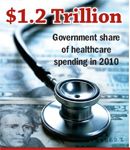Government will pay larger slice of the pie
Public spending is projected to total more than $1.2 trillion in 2010 and to account for slightly more than 50% of all national health expenditures in 2011.

This analysis, which appears in the March 2010 issue of Health Affairs, predicts that total healthcare spending will nearly double from $2.5 trillion last year, or 17% of GDP, to $4.5 trillion in 2019, when it will account for almost 20% of all domestic spending in the United States-much more than in any other nation.
The recession will rein in growth on healthcare this year, but spending will pick up as the economy improves.
Spending in private healthcare is slowing down in comparison. Private outlays are projected to grow by only 2.8% in 2010 to $1.3 trillion. The drop is largely attributed to reduced private insurance enrollment and expiration of federal subsidies to help unemployed Americans extend private insurance coverage through COBRA.
Over the next four years, public spending for hospitals, physicians and prescription drugs is expected to growth faster than private spending in these areas, further tipping the balance toward government funding.
The demand for more hospital care to treat the H1N1 virus increased spending on hospital services in 2009. However, outlays to hospitals are slated to slow down this year as a result of a drop in Medicare Advantage payment rates and lower Medicaid spending.
Meanwhile, Medicaid has spurred growth in spending for clinical services. An expected sharp drop in Medicare payments to physicians this year would have a noticeable impact on Medicare spending. Congress is expected to block that 21% rate rollback again and allow the current payment level to remain in place, as it does every year.
Private spending on physician services is projected to slow to 2.4%, again because of the recession and higher cost-sharing requirements.
The recession also has slowed growth in out-of-pocket spending. Consumer outlays on medical care will grow, however, as employers continue to pass on more costs to workers.
Spending on prescription drugs and drug utilization experienced a steeper increase, partly as a result of a rise in use of drugs to combat the H1N1 virus. Outlays should continue to rise in the next two years as manufacturers raise prices, but then slow down as generic competition heats up for a number of blockbuster medicines.
STATUS QUO IS COSTLY
One reason that future outlays on healthcare will continue to rise is that Congress so far has failed to enact health reform legislation that imposes any curbs on spending-a major criticism of Democratic-backed legislation. In fact, the proposed measures would have expanded the government role in healthcare by widening eligibility for Medicaid and boosting government subsidies to help low-income people obtain coverage.
President Barack Obama has tried to reignite the health reform initiative through an open, bipartisan discussion of the best ideas for modernizing the nation's costly and inefficient health care system. Meanwhile, Congressional leaders seek strategies for enacting the Senate reform bill. White House budget director Peter Orszag continues to support health reform legislation as the best way to bring healthcare costs under control and begin to reduce the nation's soaring budget deficit.
However, most strategies for expanding coverage to the uninsured would increase public spending and accelerate the shift away from private insurance, as outlined by the CMS actuaries.
Conversations With Perry and Friends
April 14th 2025Perry Cohen, Pharm.D., a longtime member of the Managed Healthcare Executive editorial advisory board, is host of the Conversations with Perry and Friends podcast. His guest this episode is John Baackes, the former CEO of L.A. Care Health Plan.
Listen
Ohio’s Medicaid Work Requirement Efforts Aim to Boost Engagement, Avoid Coverage Loss
April 18th 2025Maureen Corcoran, director of the Ohio Department of Medicaid, believes the work requirement policy can be both a financial and moral effort to improve the lives of Medicaid consumers.
Read More
Breaking Down Health Plans, HSAs, AI With Paul Fronstin of EBRI
November 19th 2024Featured in this latest episode of Tuning In to the C-Suite podcast is Paul Fronstin, director of health benefits research at EBRI, who shed light on the evolving landscape of health benefits with editors of Managed Healthcare Executive.
Listen
Why Better Data and Awareness Matters for Medicaid Work Requirements
April 17th 2025With policymakers considering work requirements for Medicaid eligibility, Jennifer Haley, principal research associate in the Health Policy Division at the Urban Institute, said it’s more important than ever to understand how those changes could unintentionally cause harm, particularly when data systems fall short and public awareness is limited.
Read More